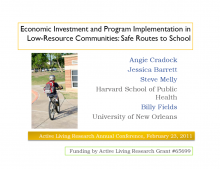We are pleased to announce an exciting new alliance between Active Living Research and GP RED to co-host and coordinate...
Economic Investment and Program Implementation in Low-Resource Communities: Safe Routes to School

Presentation at the 2011 Active Living Research Annual Conference
Background:
Considerable public investment in infrastructure and programming to promote active transportation to school has recently been undertaken through federal legislation. In 2005, the Safe Routes to School (SRTS) program was added in the reauthorization of the transportation bill Safe, Accountable, Flexible, Efficient Transportation Equity Act: A Legacy for Users (SAFETEA-LU). Further research is needed to help inform local, regional and national policy discussions about how state and federal funding programs can be successfully implemented and to identify the potential state-level policy and programmatic factors that help to foster strong SRTS programs within states and partnerships among state program administration and other stakeholders.
Objectives:
1) Develop measures of state-level SRTS program implementation; 2) Examine associations between state policy/program factors and demographic/geographic features and measures of SRTS program implementation; 3) Develop a case study series in four states to explore and further detail the mechanisms through which state policy/program and demographic/geographic factors promote or inhibit SRTS implementation.
Methods:
Design: This study uses a repeated measures, cross-sectional observational design with SRTS program funding and implementation data collected by year for each state to examine associations between SRTS program implementation and state policy/program and demographic/geographic factors. The results of national-level analyses were used to identify four case-study states. Case study methods include structured interviews, document review and secondary data analyses.
Measures:
Data documenting county and state-level federal economic investments in all 50 states through the SRTS program were obtained from the Federal Highway Administration’s funding database, the Fiscal Management Information System (FMIS). State level SRTS program implementation was characterized by: 1) the proportion of available SRTS funding that was obligated by the state for SRTS projects, and 2) per student funding obligations. State-level policy and program factors reviewed included a) state-level infrastructure/non-infrastructure project funding mix and b) prior history of state bicycle and pedestrian infrastructure investment. Key state level demographic/geographic factors included: a) state-level student enrollment in grades K-8 (public school estimates from Common Core of Data and private school estimates from Private School Survey, National Center for Education Statistics), b) geographic region (West, Midwest, Northeast and South, US Census Bureau), c) rural/urban county mix (US Census Bureau) and d) state-level population-weighted average distance to school (US Census and National Center for Education Statistics).
Results:
Overall, $220,429,000 was obligated to implement 2,296 SRTS projects in the 50 U.S. states during FY2006-2009. Implementation increased across the years of the federal funding program: $21,292,000 was obligated to implement 139 projects in 2006, $45,749,000 for 344 projects in 2007, $71,819,000 for 948 projects in 2008, and $76,430,000 for 858 projects in 2009. Preliminary descriptive analysis of SRTS economic investments at the state level revealed differences in SRTS program implementation across states (N=50). On average, states obligated 44% of available funding (range 6-100%). Average per student obligation was $11.06 (range $0.83-$68.05). Factors associated with these measures of successful SRTS program implementation include prior success implementing federally-funded bicycle and pedestrian projects, implementation of infrastructure vs. non-infrastructure activities, region, and student enrollment. In a multivariable linear regression model, higher percentage of available SRTS funding obligated in states was associated with lower percentage of funding obligated for non-infrastructure activities (β=−0.4%; SE=0.22; p=0.06), K-8 student enrollment of less than 300,000 compared to 705,000 or greater (β=18.5%; SE=8.84; p=0.04), and location in the West region compared to the Northeast region (β=26.4%; SE=10.71; p=0.02). Higher per student funding obligated in states was associated with lower percentage of funding obligated for non-infrastructure activities (β=−$0.27; SE=0.08; p=0.003), K-8 student enrollment of less than 300,000 compared to 300,000 to 704,000 (β=$10.37; SE=3.67; p=0.007) and 705,000 or greater (β=$11.48; SE=3.62; p=0.003), and prior per capita federal funding obligated for bicycle and pedestrian projects (β=0.23; SE=0.06; p=0.0004).
Conclusions:
Nationally, successful SRTS program implementation is related to state-level policy/program and demographic/geographic factors including mix of infrastructure and non-infrastructure activities, prior history of bicycle and pedestrian project implementation, state-level student enrollment and geographic region. Preliminary case study series analysis indicates that, within states, policy and programmatic factors and demographic and geographic factors are interrelated and may have complex interactions in influencing SRTS program implementation. More detailed analysis will be used to illustrate these relationships within case study states.
Support:
This work is supported by Active Living Research, a National Program of the Robert Wood Johnson Foundation.
Related Tools & Resources
STAY UP TO DATE
RECENTLY ADDED TOOLS & RESOURCES
MOVE! A BLOG ABOUT ACTIVE LIVING
The "Active Living Conference" aims to break down research and practice silos and...







